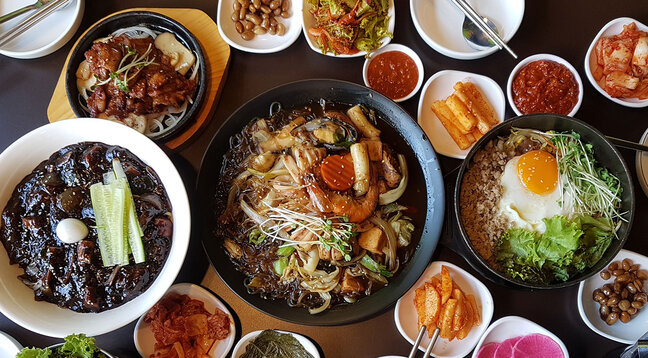

Korean cuisine is a delicious blend of flavours, textures, and smells that has won over food lovers worldwide. Its unique combination of sweet, sour, spicy, and umami flavours is worth experiencing.
If you're new to Korean food, prepare to embark on a delicious journey that will excite your taste buds.
Let's start with the basics: What makes Korean food so special? Korean cuisine stands out for its emphasis on fresh ingredients and balanced meals.
Every dish includes side dishes called banchan. These include pickled vegetables, seasoned greens, and small portions of protein. Banchan adds its unique taste to the overall dining experience.
The seasonings used in Korean cooking are sesame oil, soy sauce, garlic, ginger, and fermented pastes. These ingredients balance bold and subtle flavours, making Korean cuisine unique.
Korean dining is a communal experience where dishes are often shared. This aspect of Korean cuisine makes it socially enriching.
If you're interested in trying Korean food, there are a few dishes you'll want to add to your list.
A staple in every Korean household, this fermented vegetable dish is rich in flavour and varies in spice levels. It's a side dish and an ingredient in many Korean dishes (as you'll see now). Kimchi is also known for its health benefits, including high levels of vitamins and probiotics.
A colourful bowl of mixed rice topped with vegetables, meat, a fried egg, and spicy gochujang. This dish is a visual delight and offers a balanced meal with various ingredients. Bibimbap is often served in a hot stone bowl, which crisps the rice at the bottom.
Thinly sliced, marinated beef that's grilled to perfection. Bulgogi is known for its sweet and savoury flavour, achieved through a marinade of soy sauce, sugar, sesame oil, garlic, and pepper. It's often enjoyed wrapped in lettuce leaves with a smear of ssamjang (a thick, spicy paste).
A savoury dish of stir-fried glass noodles and vegetables often served with meat. The noodles are made from sweet potato starch, giving them a unique chewy texture. Japchae is flavoured with soy sauce, sesame oil, and a hint of sugar, balancing the dish's sweet and savoury aspects.
Spicy and sweet rice cakes are a popular street food favourite. These chewy rice cakes are smothered in a fiery red sauce from gochujang (Korean chilli paste). Fish cakes, boiled eggs, and scallions are often added to the mix, making it a hearty snack.
Korean daily meals are diverse and balanced. Here are some of the most commonly eaten foods:
A staple in every meal often served alongside various side dishes. Rice is the backbone of Korean cuisine, providing a neutral base for the bold flavours of the accompanying dishes. It's usually short-grain and stickier than other varieties, making it easy to eat with chopsticks.
Korean sushi rolls filled with vegetables, rice, and sometimes meat or fish. These rolls are perfect for on-the-go eating and are popular picnic food in Korea. The fillings vary widely, but common ingredients include spinach, carrot, radish, and egg.
Korean dumplings filled with a mixture of meat and vegetables. They can be steamed, boiled, pan-fried, or deep-fried, making them incredibly versatile. Mandu is often enjoyed with a soy-vinegar dipping sauce and can be found in soups like manduguk.
A traditional soup featuring a whole young chicken filled with garlic, rice, and ginseng. This dish is trendy in summer and is believed to replenish energy. The broth is light yet nourishing, often seasoned with salt and pepper.
A hot and spicy stew made with uncurdled tofu, vegetables, sometimes meat, and gochujang or gochugaru. This stew is known for its comforting warmth and depth of flavour. It's typically served to bubble hot in a stone pot and is a favourite during the colder months.
These dishes are nourishing and integral to the Korean way of life, reflecting the country's rich culinary heritage.
And now, for the finale! Beyond the basics, these are some of the best Korean dishes. Make sure to try one of these at least once so you get to say, "I've tried proper Korean food!":
A flavorful seafood pancake, perfect as a snack or a meal. This pancake is loaded with scallions and various seafood, creating a crunchy exterior and a soft, chewy interior. It's typically served with a tangy soy dipping sauce.
A rich and hearty stew made with kimchi, tofu, and tuna. This stew, often eaten with a bowl of steamed rice, is beloved for its comforting and robust flavours. The longer the kimchi ferments, the deeper the flavour of the jjigae.
Spicy stir-fried chicken mixed with sweet potatoes, cabbage, and tteok (rice cakes). This dish is another popular communal meal, cooked on a large pan at the table. It's a perfect blend of sweet, spicy, and savoury flavours.
A popular dessert of shaved ice topped with sweet ingredients like fruit, red bean, and condensed milk. Bingsu is incredibly refreshing during the hot summer months. The ice is excellent and fluffy, almost like freshly fallen snow.
Consider these dishes if you're curious about Korean food but know where to begin. They offer a diverse range of distinct and delightful flavours. That way, you can get the opportunity to explore the cuisine and broaden your palate.
Ibn Battuta Mall offers an exciting opportunity for those eager to delve deeper into global cuisines. As an extension of your culinary exploration, here are more insights into the types of cuisine and their famous dishes.
Share this article Share
Share this article Share
